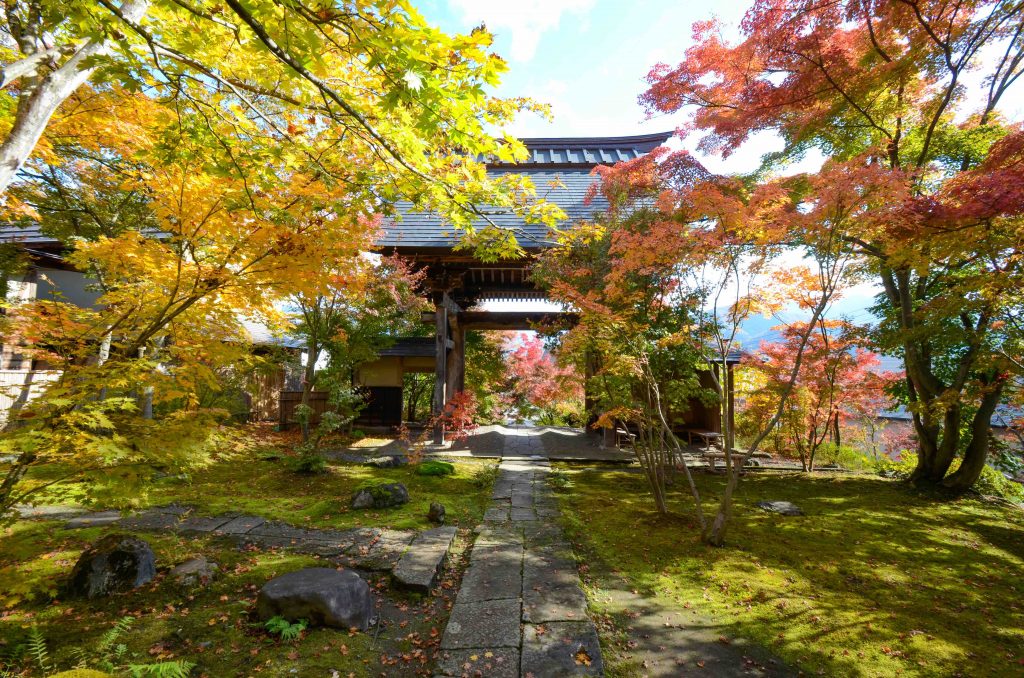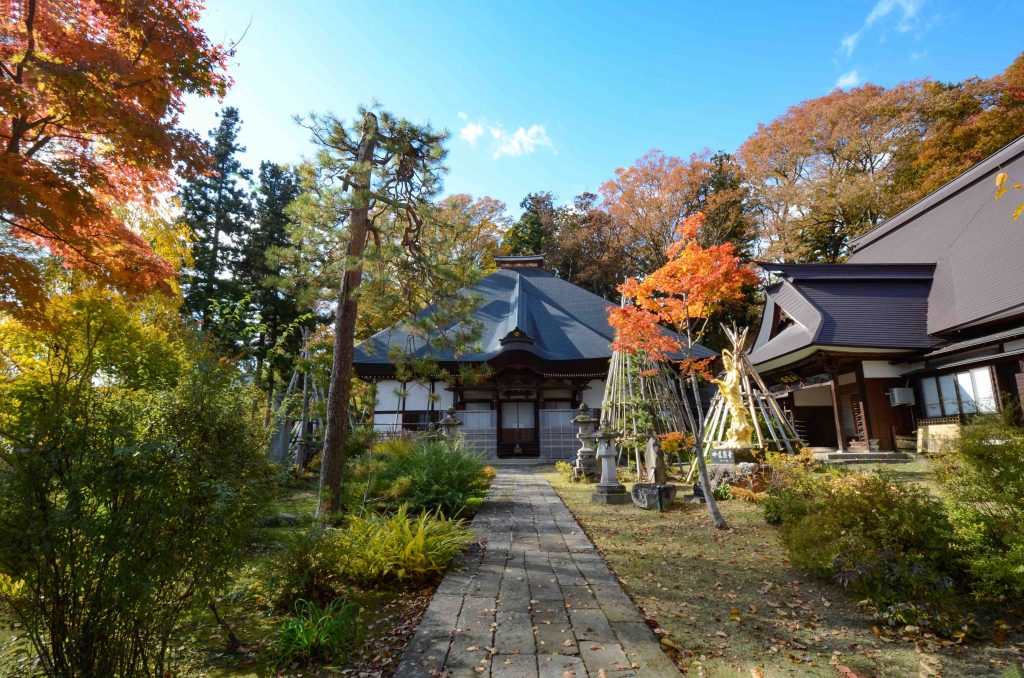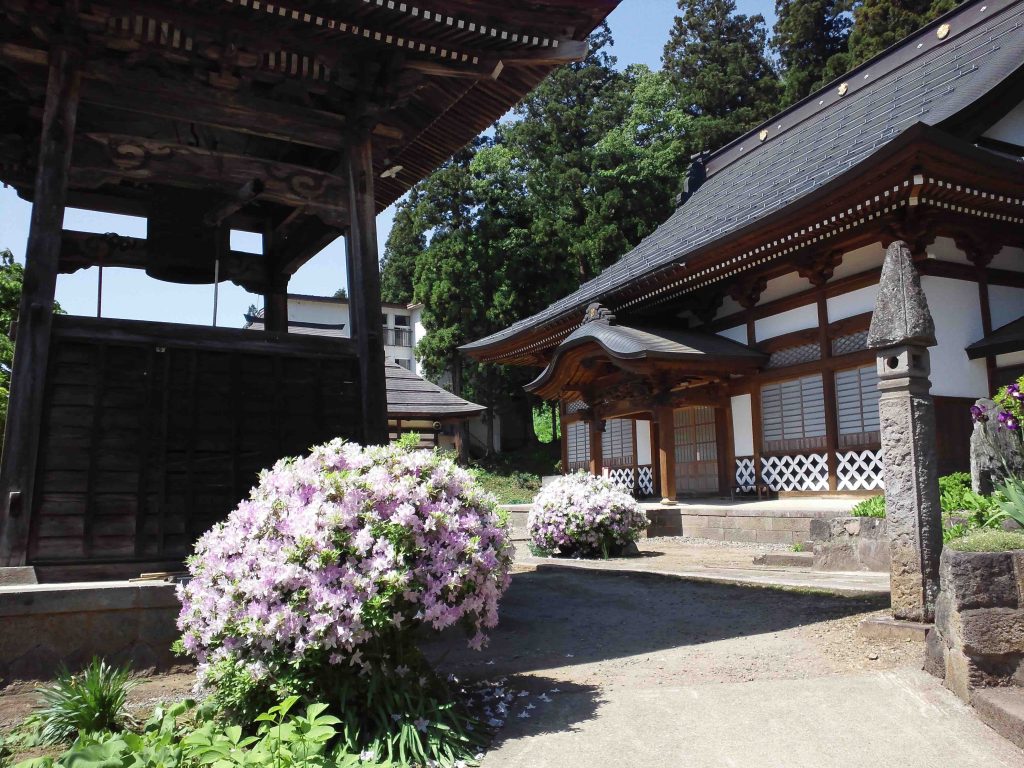
Enjoy a temple tour around Iiyama
Called “snow country’s little Kyoto” by literary master Toson Shimazaki, Iiyama is home to many temples. The city’s temple culture is captured in famous lyricist Tatsuyuki Takano’s “Iiyama kouta (Iiyama ballad),” which tells of “thirty-six temples and bells chiming in Atago.” It’s said that for ages temples have lined the Atago-machi and Shinmei-machi streets, running along the Chikuma River banks near the ruins of Iiyama castle.
Atago-machi district, with its distinctive snow-country architecture, is commonly known as a “Buddhist altar street” for the many altar shops that line the road.
Temples and shrines can be found in plenty, and a temple promenade connecting each site runs parallel to the main street. Walking along this path, you can visit and enjoy many beautiful Iiyama temples.
Recently, the old Zen temple Shojuan, used as a film location, and Shinshuji, known as the setting for the novel Hakai, have become quite well known. However, Iiyama offers many other places to see, including a tour of shrines hosting the “the Seven Deities of Iiyama’s Good Fortune,” and a temple offering vegetarian dishes prepared in the style of traditional Buddhist monks. Keep reading for an introduction to some of these temples and shrines!

Shonenji is a prominent historic temple in Iiyama, snow country’s little Kyoto. Called Kokedera (Moss temple) for its mossy grounds, it is famous for the exquisite contrast between the small, but well-maintained stone garden and the beautiful colors of its maple trees. The best time to enjoy colorful leaves in fall is early to mid November, before the snowy season. However, even during the winter, temple grounds are shoveled to allow visitors access to the main hall.
The temple was destroyed by fire in winter 1920, leaving only the main gate and the bell tower untouched. The current main temple building was reconstructed in 1968, using the Shoso-in log-cabin style of construction. The Buddhist deity Amitabha is enshrined in the temple. The bell tower has also been broadcast nation-wide during the New Year’s Eve bell ringing traditional in Japan, featured on NHK’s “Year’s End, Year’s Beginning” program.

Jokozan-kenshoin Temple
Shonenji (Shin Buddhism Otani group)The founding date of Shonenji temple (Shin Buddhism Otani group) is unknown. In fact, it was originally built in a different location (Iwaishinden-Tsukioka), as a Tendai sect temple called Kenshoin. After the temple’s conversion to Shin Buddhism in 1213, it was rebuilt and moved to several different areas before coming to its current location in 1620.
Address : 2028 Narazawa, Iiyama City

Jofukuji temple was founded by Tohaku, a Buddhist priest in 1951. The building includes a Zen meditation dojo hall, and Zen meditation is generally practiced during the morning Buddhist service.
After borrowing a round mat and taking off any accessories, visitors may enter the Buddhist alter room barefoot. Zen meditators all sit in one line facing the wall. For the hour of meditation, visitors will learn to sit with proper posture and concentrate the mind, putting all other thoughts and concerns aside. In this way, visitors can experience one of the disciplines of Zen Buddhism. Recently, scientific studies have demonstrated that practicing this shikantaza (sitting in Zen meditation) method is linked to an increase in alpha brainwaves, commonly associated with deep relaxation. Experiencing Zazen is a great way to rejuvenate a tired mind and body.
※ For rates and other information, please contact the temple directly

Ryusuisan
Jofukuji temple(the Soto sect of Buddhism)Jofukuji temple was at Kozakai (in Iiyama City) at the beginning, but Iiyama feudal lord Sakumabizennokami moved this temple to the present place to rule the castle town. It shows his devoutness. This is a temple of “Daikokuten” of “the god of wealth of the Seven Deities of Good Luck” tour. “Daikokuten” is a god of destruction and rebirth “Siva” in India and is a god of fertility in Japan.
Address: 3210 Atagomachi, Iiyama City

Chuonji temple was first founded in the Naganuma district of Nagano City in 1559, and moved to Iiyama following the transfer of Naganuma lord Kazumasa Seki in 1601. Thereafter, the temple was protected by successive generations of feudal lords in Iiyama. In particular, viewing Chuonji as a family temple, Tadasada Matsudaira contributed 16 koku (approx. 2.2 tons) of rice and Bungonokami Honda contributed 50 bales of rice for a temple memorial service. A cemetery on the temple grounds holds generations of Matsudairas and Hondas.
The main temple burned down in a large fire in 1727, and was rebuilt in 1733. In the solemn nave (open-air area) of the main temple there is a wonderful ceiling mural of a dragon.

Shojuzan Shokakuin
Chuonji temple (Jodo Buddhist sect)Chuonji temple (Jodo Buddhist sect) – Iiyama feudal lords, particularly the Matsudairas and the Hondas, considered Chuonji a family temple for approximately 150 years, from 1717 to the beginning of the Meiji era. 2001 marked the 400th anniversary of the temple’s move to Iiyama, and the beginning of intensive temple restoration efforts.
Address : 2029 Narazawa, Iiyama City

Daishoji was a family temple for the Hori and Sakuma feudal lords. It is said that Naiki Imai, a descendant of Kanehira Imai – the vassal of Yoshinaka Kiso – originally founded the temple in 1570 as a memorial for his father. Vegetarian dishes, prepared by the young chief priest trained at Eiheiji temple, are available by reservation only.
They are elaborate, original dishes, and served beautifully. Alongside common items like sesame tofu and boiled vegetables, the temple also offers dishes made from Iiyama-local plants and farm products. Daishoji is also known as the temple where Bishamonten, one of the Seven Deities of Good Luck, is deified.
※ For rates and other information, please contact the temple directly

Shoyozan
Daishoji temple (Soto Buddhist sect)Daishoji temple (Soto Buddhist sect): When it was first established, Daishoji was known as Zenshoji, and located to the north of Mt. Iikasa. After a relocation to Ario, it was finally moved to Iiyama by castle lord Hori Tangonokami Naoyori, who changed its name to Daishoji. As a family temple, Daishoji was patronized by the Hori clan. After the Hori family’s transfer, it became the family temple of new Iiyama lord Sakuma. The Sakuma family contributed 50 koku (about 7.5 tons) of rice, making the Daishoji grounds the most rice-rich of any Soto Buddhist temple in the region.
Address : 3177 Shinmeimachi, Iiyama City




